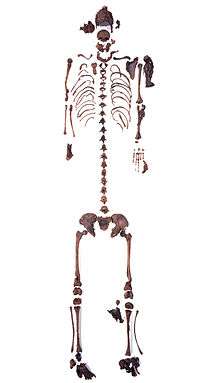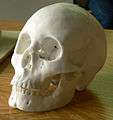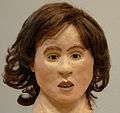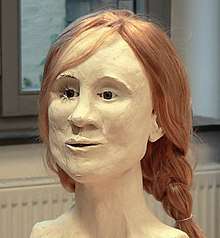Girl of the Uchter Moor
The Girl of the Uchter Moor also known as Moora is the name given to the female Iron Age bog body remains, discovered in 2000 in the marshland near Uchte, Germany. The remains include vertebrae, hair and skull pieces. The studies of the body began in 2005. The radiocarbon dating performed at the University of Kiel showed that Moora had died between 764 and 515 B.C. Despite common Iron Age burial practices,[1] the body was not cremated. All of the body parts are estimated to have been found except for one scapula.[2]

Before DNA analysis and Radiocarbon Dating, the body was initially believed to be that of a sixteen-year-old girl, Elke Kerll, who had disappeared in 1969 after going to a dance club.[1][3]
Analysis
Moora was determined to be between 17 and 19 years old at the time of her death.[1] She was left-handed.[3] It is thought that Moora experienced intense physical labour and likely repeatedly carried heavy loads, like water jugs, while roaming through the marshland.[1] According to Saring Dennis from the University Hospital Hamburg-Eppendorf, Moora sustained at least two partial skull fractures that gradually healed themselves.[3] Moora also suffered long periods of sickness associated with the hardships of long winters.[3] The bone growth lines showed that during her childhood and adolescence, Moora suffered from chronic malnutrition.[3] Moora was also diagnosed to have a benign tumor at the base of her skull, which led to the spine curvature and chronic inflammation in the leg bones.[3] However Moora's cause of death is unknown. It was only determined that Moora was naked at the time she was deposited into the bog.[1]
Facial reconstructions
Moora's face has been reconstructed four times, two of which were digital. The two that were created in the traditional way had been created by molding material over a plastic replica of the skull. The artist had to estimate the shape of the girl's lips, hair color and skin tones, similar to the process of the Yde Girl. [4] The digital reconstructions were created by Ursula Wittwer-Backofen. [5]
 3D reconstruction of the skull
3D reconstruction of the skull Facial reconstruction with brown hair
Facial reconstruction with brown hair Facial reconstruction with red hair
Facial reconstruction with red hair One of two digital reconstructions by Ursula Wittwer-Backofen
One of two digital reconstructions by Ursula Wittwer-Backofen
References
- "Scientists model ancient bog woman's face". The Local. 21 January 2011. Archived from the original on 24 January 2011. Retrieved 24 January 2011.
- "Ancient 'Bog Body' Unearthed in Germany". All Voices. 24 January 2011. Retrieved 24 January 2011.
- "Identify the remains of Iron Age woman". All Voices. 24 January 2011. Retrieved 24 January 2011.
- "Pictures: Ancient Bog Girl's Face Reconstructed". National Geographic. Retrieved 17 January 2014.
- "The Story of Moora". Weebly.com. Retrieved 17 January 2014.
External links
| Wikimedia Commons has media related to Girl of the Uchter Moor. |